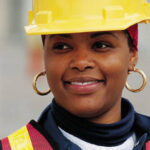One Size Doesn’t Fit All When It Comes to PPE

Nearly every workplace has workers of both genders, although the ratio may be skewed toward one sex or the other depending on the industry. Bans on discrimination based on gender mean employers can’t treat female workers differently than male workers in terms of salary, promotions, discipline, etc.
But the fact is there are differences between men and women that can have safety implications. And safety coordinators must properly address gender differences to ensure the safety of all workers. (Use this checklist to determine how effective your OHS program and safety policies are at addressing the needs of female workers.)
PPE is a good example of an area in which these differences may be heightened.
For PPE such as hardhats, safety glasses, respirators, etc. to be effective, it must fit properly. In general, women are smaller than men. And the range of available sizes for PPE is often limited and provides more larger size options than smaller. As a result, female workers may be stuck with ill-fitting PPE. (Workers who are overweight can face similar issues.)
What can happen when PPE doesn’t fit female workers properly’ According to a publication by the IAPA on PPE and women, ill-fitting PPE can jeopardize the health and safety of female workers and their co-workers. Here are some examples:
- A woman with a small face wears goggles that leave gaps at her temples, allowing flying debris from her machine to enter her eyes.
- A female worker in a sawmill can only get small men’s gloves. The fingers are too long and too wide. As a result, she risks getting her glove caught in machinery and pinched, injuring her hand.
- A woman who wears men’s-sized work boots complains of tripping while walking and climbing stairs or ladders. She suffers from blisters and burning on the soles of her feet. Also, because her boots are too large, her toes aren’t protected by the steel cap.
Whenever possible, try to provide PPE for female workers that’s actually intended and designed specifically for their use. And here are some tips from the IAPA on selecting various kinds of PPE for female workers:
Hardhats. If you can’t get hardhats that are small enough for female workers, adding a chin strap to hats that are too large may provide a better fit.
Safety eyewear. Women are usually able to find safety glasses that fit properly. But safety goggles are a different matter. They often come in one-size-fits-all, which may not actually be the case. Such goggles may still be too large for female workers, letting materials, sparks or chemicals into their eye areas. So look for goggles with an adjustable strap, which can help eliminate gaps.
Hearing protection. Women generally have smaller ear canals than men. So disposable, foam ear plugs may fit them better and more comfortably than pre-moulded types.
Safety footwear. Manufacturers are now making safety footwear specifically for women that’s more comfortable and fits better. So make sure female workers actually wear footwear designed for them when it’s available. Note that some types of safety footwear, such as chain saw boots, may still not be available in female models.